Remote sensing derived edge location, magnitude, and class transitions for ecological studies
Bosque Modelo:
Foothills
Temática:
Gestión forestal
Tipo de documento:
Artículo científico
Resumen
Regionally intensive human activities related to resource extraction (i.e., harvesting, oil and gas extraction) are increasing the occurrence of edges found in some forested landscapes. Edges between different land cover types represent important transition zones for abiotic and biotic processes. However, boundary detection methods often identify edges solely in areas of high contrast, such as transitions between forest and non-forest areas, and are insensitive to the relative contrast and orientation of different transitions. Edge contrast and orientation can determine the magnitude and even the occurrence of ecological edge effects and should be measured to provide information on landscape condition and habitat potential. Wombling was applied to the wetness component of a tasselled cap transformation (TCT) of a Landsat scene acquired over a portion of the eastern slopes of the Rocky Mountains in Alberta, Canada. By incorporating wombled edge contrast and orientation, and edge class transition type obtained from a land cover dataset, the nature of all transitions between land cover classes within the image was characterized and quantified. The consistency between edges identified by wombling and other common methods of edge delineation (such as spatial clustering) and methods of edge quantification (such as landscape pattern indices, or LPIs) was also assessed. Land cover transitions showed a broad range of edge contrast. Comparisons of edge contrast and the LPI edge density showed a positive correlation (r 2 5 0.33); however, the strength of this relationship varied with the dominant land cover type (e.g., r 2 5 0.016 for broadleaf open forest to r 2 5 0.48 for dense coniferous forest). Stratifying edge contrast to higher values (i.e., .1 standard deviation) increased agreement with edge density, indicating that the LPI is preferentially relating high contrast edges. This study demonstrates how unique edge characteristics may be generated from a remotely sensed continuous variable (TCT wetness). This knowledge of the location, magnitude, and class transitions found at edges provides insights into the nature of the edge effects and enables the development and testing of hypotheses informing wildlife habitat use and selection.
Información Bibliográfica
Autor:
Wulder, M.A., Stewart, B.P., Andrew, M.E., Smulders, M., Nelson, T., Coops, N.C., & Stenhouse, G.B.
Revista:
Canadian Journal of Remote Sensing
Año:
2009
N°:
5
País :
Canadá
Páginas:
509 - 522
Volumen:
35
Idioma:
Ingles
Palabras claves
land cover, Model forest, correlation





